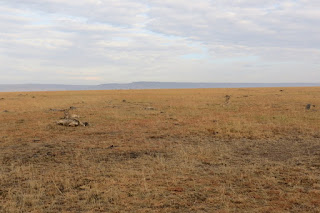This was our last safari on this trip. When we were asked by the guide what we wanted to see today, we all said that we wanted to see a rhino. In the previous safari, we had gone east and west of the Olkiombo Airstrip, and this morning Rafael first drove us to cross the tributary of Talek River. On the road, we saw a giraffe lying on the grasses with its long neck sticking out like a pole. Before, we always saw it standing up. We saw Egyptian geese in the tributary.

 |
|
After crossing, we had a good view of the plain under the early morning sun. The top of the grass field seemed had been painted by a great artist with all tones and hues of gold and deep orange. It was really gorgeous. After driving for about 5 km, we reached a large plain with many animals. Warthogs were quite commonly seen animal everywhere in the park, but they were very nervous, and it was very difficult to catch a photo of them. I was glad that I got one this time. We had seen topis, zebras and gazelles in other places of the park, but here there were more of them in number. For the first time we saw vultures nesting on top of a lonely tree, and a sick or injured lion lying on the grasses. And the grasses around it were tainted with blood. A lonely hippo was also found in the plain, and it was over a kilo metre from the river. Two hyena were cooling in a temporary dents on the road side. They were watching very closely of the animals around them and waiting for some easy meals.

We turned back after watching the lions, and saw a crown eagle proudly perching high on top of a tall acacia tree. Its intense eye watched closely of its territory. A group of four ostrich were strolling on the trail. They were disturbed by our car, and started to run to the grasses on the side of the trail.
As we started crossing the tributary of Talek River, we saw a group of elephants foraging in the woods on the eastern bank of the tributary. They went deeper inside the woods as we passed them. And this concluded our safari in Masai Mara.
In summary, we saw the lion, elephant, leopard, cheetah, hyena, crocodile, hippo, buffalo, eland, giraffe, topi, impala, grant gazelle, Thompson gazelle, did-dik, baboon, ostrich, fish eagle, crown eagle, vulture, goliath heron, secretary bird, Hartlaub's bustard, bushstrike grey-headed, Ruppell's robin chat, Egyptian goose, grey crown crane, guineafowl, and Ruppell's longtail starling. We didn't see any rhino.
The tour package included 3 safari each day, and we had only 5 safari. We could have booked a later flight leaving Masai Mara in early afternoon, carried a packed breakfast, and combined the 5th and the 6th safari together to go farther to look for the rhino. The extra cost would be the expensive lunch of US$50 for each person if we wanted to have it at the end of the safari.
More photos can be seen by searching "lku99999, photo" in Google.

















































